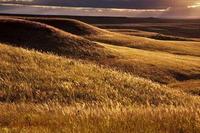Flint Hills featured in National Geographic Magazine
 For the April issue of National Geographic magazine, long-time photographic contributor Jim Richardson tackled a subject familiar to central Kansas residents in an unfamiliar light - he put the Kansas Flint Hills on display, portrayed with fireflies, starlight and aerial views.
For the April issue of National Geographic magazine, long-time photographic contributor Jim Richardson tackled a subject familiar to central Kansas residents in an unfamiliar light - he put the Kansas Flint Hills on display, portrayed with fireflies, starlight and aerial views. The magazine published a 22-page story about this distinctive Kansas landscape by Richardson and respected essayist Verlyn Klinkenborg. Millions of people worldwide will see the beauty Kansas' Flint Hills have to offer.
"The Flint Hills shouldn't be right now playing second fiddle to the Grand Canyon in the pages of the National Geographic. I was not going to go out with the assumption what we have here in Kansas is any lesser than the great American landscapes and I want people to open up those pages and say, "My gosh, I had no idea that was there," says Richardson.
Richardson, who also shot the Flint Hills during his first job as a news photographer for the Topeka Capital-Journal, worked on the Geographic project from last spring until September. He got up in small planes and down in the grass with a macro lens. He shot at all times of the day and night, and in all seasons. Only once did he have an uncomfortably close encounter with wildlife: A skunk ran him out of a meadow of wildflowers.
“The amazing thing about the Flint Hills is that - seeing them at drive-by speeds — while they look simple, they are highly complex,” he says. “The community of plants and animals that live there, who make a living in a harsh environment, is quite amazing. It’s a place that rewards you for looking long and hard.”
With a magazine that reaches 50 million hands, the pictures are expected to boost the $5.6 billion tourist industry in Kansas. "We think this is going to move the needle on tourism to have that many people who see the magazine and most of them not realize this is even in Kansas, we definitely think it'll move the needle," says Richard Smalley, KS Dept. of Commerce, Tourism Division.
The Flint Hills emerged from the erosion of limestone and shale that contained high levels of chert, or flint. Most of the bottomland prairie has been planted to corn and milo, but the uplands - which dominate — remain mostly unspoiled. “The flint in the Flint Hills is the only thing that kept this area from being developed and farmed. Nature itself prevented the ploughs from tilling the upland prairie,” says Heather Brown, chief of interpretation at the Tallgrass Prairie National Preserve. “Usually people find a way, but Mother Nature won.”
The preserve opened in 1996 and covers nearly 11,000 acres — a mere fraction of the hill system. Visitors learn that only 4 percent of America’s original tallgrass prairie still exists. Last year, more than 20,500 people journeyed to the preserve, where guided walking and bus tours introduce them to the prairie ecosystem. “We’ve had people from all over the world come to the preserve,” Brown says. “Especially when they come from areas that are densely populated, it’s amazing the reaction that is on their face. They can’t believe there’s this much open space.”
She hopes to lure as many people as possible to the national park to increase awareness of the beauty and rarity of the Flint Hills.
Learn about visiting the Flint Hills and getting up close and personal with the tallgrass prairie by visiting the Web site of the Tallgrass Prairie National Preserve: nps.gov/tapr/
To learn more about the Flint Hills visit: kgs.ku.edu/Extension/flinthills/flinthills.html
For the National Geographic online visit: nationalgeographic.com/ngm/0704/feature5/

